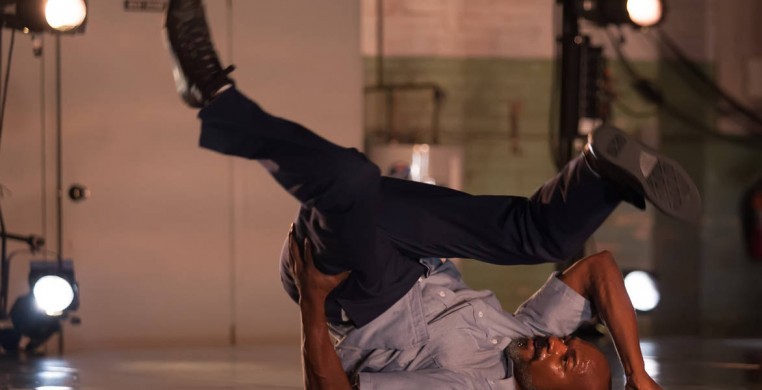It was a rather brief evening of theater. And dance. And theatrical dance--at Columbia College on Thursday. This last event, in a two week hip-hop series of concerts, workshops and panel discussions called B-Real, provided something completely different from the previous weekend’s Compagnie Kafig. (see review 2/23/2014)
Raphael Xavier came with just two dancers in tow, and provoked, perplexed, and bowled over the audience at the Dance Center last Thursday. Considering the series as a whole, one gets the sense of the wide range of possibilities within hip-hop as a genre. In his Unofficial Guide to Audience Watching Performance, Xavier offers an autobiographical montage of his life through three shades of himself. The opening scene is a slow motion glimpse at the three Xaviers: one a studious substitute teacher (portrayed by Xavier himself), one a tough bully, and one the subject of the bully’s attention. The young version of Xavier struggles and ultimately finds solace in breakdancing. Upon arriving at “school,” Xavier puts the audience through a lesson on “cultural transmission.” The house lights rise, and audience members become pupils. He scolds us for not having prepared. Xavier’s comedic timing in his speech and his dancing leave enough room for us to feel awkward and uncomfortable, but not enough to really squirm.
As the school lesson progresses, we begin to learn that this is about more than Raphael Xavier’s life; it's a lesson about watching live performance. He attempts to instruct us on the definition of cultural transmission. The definition didn’t stick, but a couple of key points about watching did: “My job is to imagine being you. Your job is to imagine being in the moment… now,” says Xavier. Spats of breakdancing follow the more poignant moments of text, often in isolated spotlights, which seem to reveal some sort of truth or moment of importance for the three dancers onstage. Xavier as studious professor sits in one such spotlight, pretending to write on a chalkboard. It’s a gesture that would return from time to time reinforced audibly by a scratching of chalk in the sound score and visually by residual half-circles from white sneakers on the dark marley floor. We are being intentionally schooled on Xavier’s life, on what it means to be an audience member, and on the significance of breaking for kids needing a place to funnel their anger and frustration.
“I cut class,” he says, “but I trained for the street… that’s how I did it in 1983… if we were caught breaking, we were expelled. In case we were caught, it would be worth it.”
The Unofficial Guide to Audience Watching Performance is a strange mix of smartly employed theatrical gimmicks, casual street dancing, modern dance sentimentality, and a more formal iteration of hip-hop. It’s a fusion of vocal and visual cues that are more complex than at first they seem. The solicitation of audience participation, in which they are invited to turn in term papers, speak when called on, and enter the stage as directed to take photographs, is a bold and sophisticated choice, but the chaos is utterly controlled. Xavier is playful with the audience, but not really. There’s an underlying feeling that it’s only okay to break the rules he says you can break. One wonders what would happen if members of the audience broke Xavier’s broken rules and offered their contributions without invitation. My, wouldn’t that be interesting?

